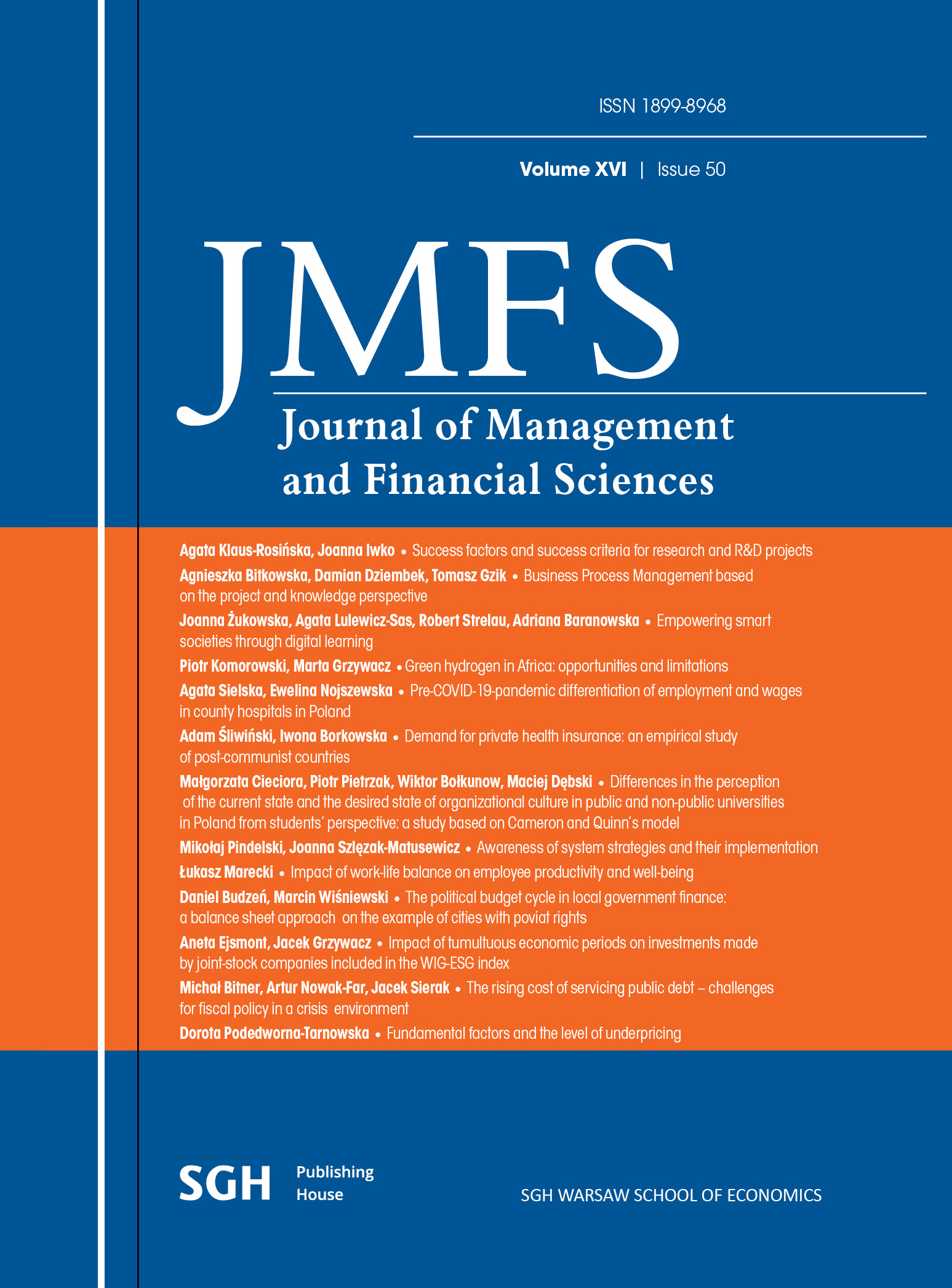Impact of tumultuous economic periods on investments made by joint-stock companies included in the WIG-ESG index
Main Article Content
Abstract
The aim of the article is to assess the role of ESG assumptions in dealing with complex crises that are both economic and financial in nature. The research problem is excessive fluctuations in the quotations of the WIG-ESG index, which includes listed companies characterized by adherence to the principles of socially responsible business. An attempt will be made to verify the research hypothesis, which assumes a positive impact of selected stock market indicators on the stabilization of quotations of the analyzed index. The research method will be the estimation of an econometric model built from dependent variable Y describing changes in the quotations of the WIG-ESG index and six independent variables describing selected stock market indicators exerting a greater or lesser influence on the changes in the quotations included in the monthly time interval in the research period January 2014–November 2023. It is concluded that the relationship between stock market capitalization and the value of equity estimated at the end of the last quarter is the basis for stabilizing the quotations of the index.
Downloads
Article Details

This work is licensed under a Creative Commons Attribution 4.0 International License.
References
Compact publications
Kawaguchi, M. (2017). The Evolution of ESG Investing: from Ethical Concern to Corporate value. The Tokyo Foundation for Policy Research, https://www.tkfd.or.jp/en/research/detail. php?id=407
Kecskes, A., Mansi, S., Nguyen, P.‑A. (2014). Does corporate investment in stakeholder capital create value for shareholders? The importance of long-term investors, Working Paper, York University.
Press and occasional articles
Chang, L., Wenjing, L., Rose, L. (2023). Government Engagement, Environmental Policy, and Environmental Performance: Evidence from the Most Polluting Chinese Listed Firms.
Business Strategy and the Environment, 24 (1), DOI:10.1002/bse.1802
Cohen, G. (2023). The impact of ESG risks on corporate value. Review of Quantitative Finance and Accounting, 60, pp. 1451–1468, https://doi.org/10.1007/s11156-023-01135–6
Dikolli, S. S., Frank, M. M., Guo, Z. M. Lynch, L. (2022). Walk the talk: ESG mutual fund voting on shareholder proposals. Review of Accounting Studies, 27, pp. 864–896, https://doi.org/10.1007/s11142-022-09692-2
Eccles, R. G., Ioannou, I., Serafeim, G. (2014). The impact of corporate sustainability on organizational processes and performance. Management Science, 60 (11), pp. 2835–2857.
Heinkel, R., Kraus, A., Zechner, J. (2001). The efect of green investment on corporate behavior. Journal of Financial and Quantitative Analysis, 36 (4), pp. 431–449.
Jin, I. (2022). Systematic ESG risk and decision criteria for optimal portfolio selection. Journal of Portfolio Management, 48 (10), pp. 206–225, doi.org/10.3905/jpm.2022.1.418
Pástor, L., Stambaugh, R. F., Taylor, L. A. (2021). Sustainable investing in equilibrium. Journal of Financial Economics, 142 (2), pp. 550–571, DOI10.1016/j.jfineco.2020.12.011
Useche, A. J., Martínez-Ferrero, J., Alayon-Gonzales, J. L. (2023). Socially responsible portfolios, environmental, social, corporate governance (ESG) efficient frontiers, and psychic dividends. Corporate Social Responsibility and Environmental Management, Early Access OCT, pp. 1–17, https://doi.org/10.1002/csr.2635
Wang, Y., Delgado, M. S., Xu, J. (2023). When and where does it pay to be green? – A look into socially responsible investing and the cost of equity capital. International Journal of Corporate Social Responsibility, 8 (1), pp. 1–23, https://doi.org/10.1186/s40991-023-00077-5
Youssef, S. B., Dinar, Z. (2011). Regulation of a duopoly and environmental R&D. Environmental Economics, 2 (3), pp. 47–51.
Zhang, D. Y., Kong, Q., Shen, M. (2023). Does polycentric spatial structure narrow the urbanrural income gap? – Evidence from six urban clusters in China. China Economic Review, 80 (5),101999 80, DOI:10.1016/j.chieco.2023.101999
Zhang, D. Y., Kong, Q., Wang, Y., Vigne, S. (2023). Exquisite workmanship through net-zeroemissions? The effects of carbon emission trading policy on firms’ export product quality. Energy Economics, 123 (1), 106701, DOI:10.1016/j.eneco.2023.106701
Zhang, D. Y., Meng, L., Zhang, J. T. (2023). Environmental subsidy disruption, skill premiums and ESG performance. International Review of Financial Analysis, 90 (1), 102862, DOI:10.1016/j. irfa.2023.102862https://doi.org/10.1016/j.irfa.2023.102862
Internet materials
Chen, J. (2022). What Is a Socially Responsible Investment (SRI)?, https://www.investopedia. com/terms/s/sri.asp#:~:text=Socially%20responsible%20investing%20%28SRI%29%2C%20also%20known%20as%20social,for%20socially%20responsible%20investments%20is%20socially%20conscious%20investing [accessed: 01.11.2022].
https://gpwbenchmark.pl/karta-indeksu?isin=PL9999998955 [accessed: 26.12.2023].
https://mojafirma.infor.pl/biznes/wiadomosci/5610720, esg-co-to-jest-i-co-oznacza-dla-firmy. html [accessed: 16.11.2022].
https://www.esg.org/what-is-esg [accessed: 25.12.2023].
https://www.gpw.pl/esg-gpw [accessed: 26.12.2023].
https://www.gpw.pl/statystyki-gpw#2 [accessed: 26.12.2023].
https://www.stockwatch.pl/gpw/indeks/wig-esg,sklad.aspx#informacje [accessed: 26.12.2023].
Popovska, T. (2023), What is the Beta Coefficient? https://rankia.pl/jak-grac-na-gieldzie/wspolczynnik-beta-jak-dziala-i-czym-jest/, accessed on: 13.09.2023.
